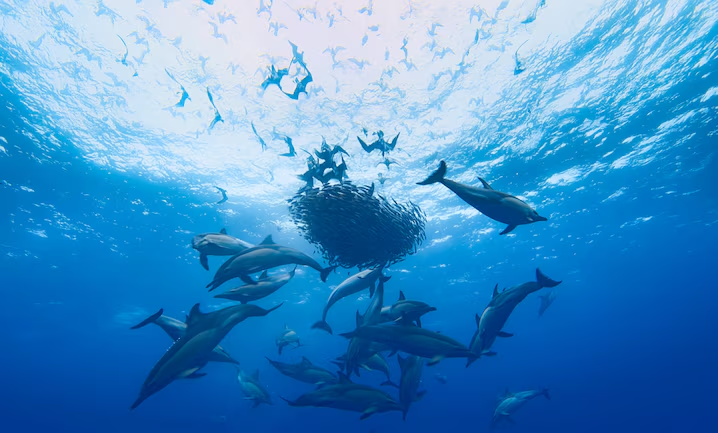Intro: A Dramatic Undersea Chase
Imagine a dark, swirling mass in the ocean—hundreds, maybe thousands, of shimmering fish darting in perfect formation. Suddenly, dolphins appear, slicing upward from below, followed by seabirds dive-bombing the chaos. This is a bait ball, one of nature’s most striking predator-prey spectacles. Dolphins, sharks, tuna, and seabirds all converge, each trying to score a meal.
What Is a Bait Ball?
A bait ball is a tight, spherical cluster of fish—often small schooling species—that band together to defend against predators. By gathering in this dense group, the fish:
- Appear larger as a collective, making it harder for predators to single out one individual
- Reduce the number of “exposed” prey at the edges where attacks are most likely
- Use their sensory systems (like the lateral line) to move in highly synchronized ways, confusing attackers and minimizing gaps in the group
Dolphin Tactics: Teamwork, Strategy, and Precision
Dolphins are not lone hunters when it comes to bait balls. Their approach reveals remarkable coordination:
- Encirclement: Some dolphins form a ring around the bait ball, keeping the fish from escaping in certain directions.
- Role shifts: Others swim through, under, or alongside the cluster, taking turns attacking or driving prey inward.
- Communication: Whistles, clicks, body movements—these are all tools dolphins use to coordinate, especially when roles shift mid-hunt.
- Adapted tactics by location: Near reefs or shallower waters, the bait ball might be pinned against physical features. In deeper, open water (like around the Azores), the strategy is more about compression and containment from multiple angles.
Why Bait Balls Work (Both for Fish and Predators)
For Fish
- Safety through numbers—less chance that any one fish will be eaten
- Reduced visibility; predators have a harder time targeting just one fish
- Collective sensing of danger via pressure waves, vibrations, etc., allowing near-instant reactive movement
For Dolphins & Other Hunters
- Energy efficiency: instead of chasing solo, the group strategy means less wasted motion
- Higher success rate: restricting the fish’s escape routes increases chances of capture
- Equal sharing: with role rotation, each dolphin gets access to prey
Beyond Dolphins: A Broader Marine Phenomenon
Although dolphins may steal the spotlight, bait balls attract multiple predators:
- Seabirds dive from above, trying to snag fish slipping out of the school’s surface
- Larger fish (tuna, sharks) converge from below and the sides
- In some rare cases, even baleen whales may join in, consuming smaller schooling fish as the chaos intensifies
Conservation Connections & What It Tells Us
- Ecosystems with plentiful schooling fish are crucial for supporting predator species like dolphins. Overfishing of bait species can ripple up the food chain.
- Marine environments where bait-ball hunting happens highlight healthy biodiversity and balanced predator-prey relationships.
- Observing these hunts teaches us about animal intelligence: communication, cooperation, role specialization—all traits once thought uniquely “human.”
Keywords: dolphins hunting, bait ball, marine predators, schooling fish, ocean life, teamwork among dolphins

